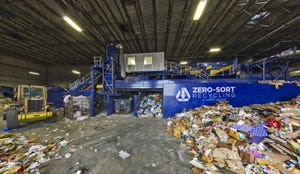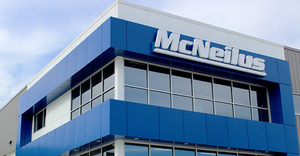Landfill profiles: Construction
August 1, 1995
David Porter and William Stafford
It was April 1993 and solid waste managers in the city of Corsicana, Texas, were running out of time. Their central Texas regional landfill, which served five counties, was expected to reach capacity in six months.
Although plans were underway to construct a 297-acre landfill adjacent to the existing facility, permitting delays left the city with less than six months to prepare bids and construction documents and to build the new site. Failure to meet the October deadline would jeopardize other contracts with surrounding municipalities and private waste management firms.
It's particularly ironic that this city of 23,000 people faced this situation, because it took the appropriate steps to prepare for its disposal needs. For example, in 1990, when Subtitle D was still on the horizon, HDR Engineering's Dallas office began preparing a landfill permit application for submission to the Texas Department of Health. Two years later solid waste permitting was transferred to the Texas Water Commission (TWC). The already confusing permit review process became a regulatory nightmare as new TWC staff members brought new interpretations of the evolving rules. Consequently, virtually no new landfills were permitted until early 1993.
Construction Plans Since the landfill is located along the eastern edge of the Corsicana Shallow oil field, soil and groundwater sampling tests were conducted to determine if petroleum hydrocarbons had contaminated the site. The samples reportedly proved that contamination existed below the planned maximum excavation depth of 32 feet. Nonetheless, the city developed a contingency plan for removing contaminated soil and plugging or removing the old oil wells. This plan was incorporated into the permit and construction documents.
By the time the TWC approved the permit, the development period had eroded to less than six months. The plan required excavating 400,000 yards of soil for the first 10-acre waste cell and building a 10-foot high perimeter berm and a 1,200-foot concrete access road from the entrance of the current site to the new landfill's maintenance area. In addition, the maintenance area needed a leachate storage tank containment area, outlet structures and a lined runoff containment pond and stormwater detention pond (see diagram on page 51).
The liner system was designed to include two feet of compacted clay under a 60-mil HDPE flexible membrane. The chosen lateral leachate drainage layer was a 12-inch gravel lift on the bottom area and geonet/geocomposite on the 3 H:1 V excavation sideslopes. The drainage layers were topped with a geotextile filter layer and protective cover soil.
The initial leachate collection system required 1,800 feet of six-inch HDPE collection pipe wrapped with geotextile and imbedded in a gravel-lined trench; 1,100 feet of four-inch HDPE leachate transfer line, which was placed in a lined trench from the leachate sump to a 10,000-gallon storage tank at the maintenance area; and a leachate sump with a submersible pump and associated level sensors, controller cabling, power center, alarms and a transport pump with 3,000 feet of four-inch force main to bring leachate from the storage tank to the city's wastewater treatment plant.
Getting Down To Business To save time, the engineering team prepared a separate bid package for waste cell excavation. The city's responsibilities included clearing 15 to 20 acres for sector one construction, providing survey control for excavation and inspecting the construction on a daily basis. In addition, the landfill supervisor monitored the excavation for hydrocarbon contamination and the engineering team periodically inspected the construction to ensure that it conformed with specifications.
The L.H. Lacy Co., Dallas, was awarded the contract for excavating 350,000 yards of material. The contract required leaving approximately 50,000 yards of the material in place at the sector's north end. The material would be used later for building half the liner and the perimeter and detention pond berms. To close the existing landfill, the city placed 50,000 yards of the excavated material over the existing site and the remainder was stockpiled for future use.
In 40 days, the site had to be mobilized, excavated and demobilized. To prepare for the tight agenda, Lacy quickly moved its equipment on-site and installed erosion control fences. Fortunately, the city had already cleared the 20 acres of "scrub mesquite and rattlesnakes" during the previous month.
Due to fair weather and the 12, 23-yard scrapers which the L.H. Lacy Co. operated day and night, the job was completed five days ahead of schedule. Also, to the city's benefit, no oil wells or contaminated soils were uncovered during the initial excavation.
The Next Step The Corsicana Landfill was one of the first sites in Texas that was built to Subtitle D standards. Consequently, unfamiliarity with this type of construction coupled with the short time frame prevented many firms from submitting construction bids.
The city awarded its construction contract to T.J. Lambrecht Construction Inc., an Illinois-based company who submitted a construction bid which matched the cost estimate. Lambrecht served as the project's general contractor and was responsible for the earthwork and gravel placement. Eagle Construction Co. built the drainage and leachate collection system and Falcon Environmental Lining Systems was hired to install the FML and geotextile. An Austin, Texas, firm was used to provide QA-QC services during composite liner construction and to prepare the necessary documentation.
Construction of the liner system proved to be a challenge. For example, the site's consolidated, blocky clay soil had to be pre-processed before it could be placed and compacted. To avoid the time consuming discing process, Lambrecht used an asphalt reclaimer.
Also, in the heat of the summer, workers prevented moisture loss and desiccation in the clay by placing the FML, gravel drainage layer and protective soil immediately after the clay was placed. Clay liner construction began in the southern half of the sector and moved to the north end while the FML, gravel and cover soil were placed at the south end. In the end, despite some TWC staff members' concerns about the sequence of liner construction, the liner passed all tests and it was approved by the state.
The heat also presented some challenges for the FML installation. For example, the FML, which was unrolled in the morning, would reach temperatures as high as 120 degrees in the afternoon heat. As a result, installers had to monitor for expansion wrinkles and folds, especially on landfill sideslopes.
The new landfill received its first load of waste five days before the old landfill was scheduled to close. The city attributes its success to proper planning, a cooperative team effort and good fortune.
You May Also Like


